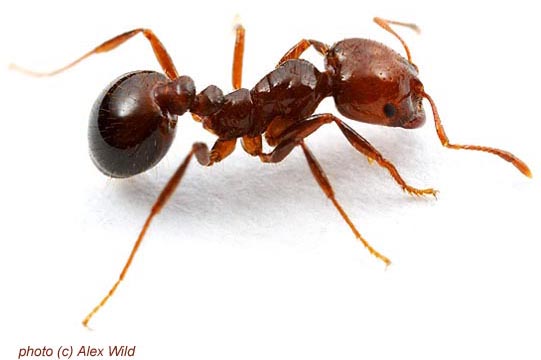The red imported fire ants, Solenopsis invicta, also known as the RIFA is native to South America. In 1930, the RIFA were introduced into United States through the seaport of Alabama. Ships from Brazil unloaded goods infested with RIFA and since then they have spread through America. The ants respond to pheromones released by the first ant that attacks and sting together at the same time. They are highly aggressive and their sting contains necrotising, alkaloid venom resulting in itchy, painful pustules. Fire ants live in colonies of 100,000 to 500,000 ants. The queen ant can lay from 1500 to 5000 eggs a day thus explaining its high population.
These ants are attracted to electric circuits and therefore accumulate in electrical equipments like traffic light and air conditioner. The damage to traffic lights in Texas is because of these ants. So how do these ants gather at the electric circuits. Research has shown that ants respond to electric stimulus by producing semiochemicals which in turn attracts more ants and this invasion causes damages and short circuiting of the electric circuits (Vander Meerl, Slowik & Thorvilson, 2002). Research has also shown that the attraction is directly proportional to the field strength of direct current and alternating current (Mackay, 1992).
The actual reason of attraction is still not really known but this attraction has caused America billions of dollars a year because of the damage to electrical equipment such as air conditioners, electrical and utility units, traffic signal boxes, telephone junctions, electric pumps for oil and water wells, airport landing lights, computers, and even car electrical systems.
References:
“Fire ants vs humans – BBC” by BBC Worldwide Youtube Channel, 9 March 2008. URL: http://www.youtube.com/watch?v=3vVUh-194vU&feature=fvw (accessed on 7 March 2010).
Mackay, W. P., S. Bradleigh Vinson, J. Irving, S. Majdi, C. Messer, 1992. Effect of electrical fields on the red imported fire ant (hymenoptera: formicidae). Environmental Entomology, 21(4): 866-870.
“Red imported fire ant (Solenopsis invicta)” by Arizona-Sonora Desert Museum. URL: http://www.desertmuseum.org/invaders/invaders_fireant.htm (accessed on 7 March 2010).
“Solenopsis invicta” by Alex Wild. The University of Texas at Austin. URL: http://www.sbs.utexas.edu/fireant/Images/Solenopsis_invicta1.JPG (accessed on 7 March 2010).
Vander Meer, R. K., T. J. Slowik and H. G. Thorvilson, 2002. Semiochemicals released by electrically stimulated red imported fire ants, Solenopsis invicta. Journal of Chemical Ecology, 28(12): 2585-2600.

